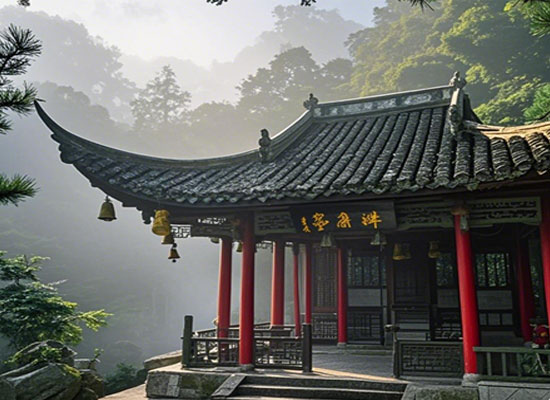Langya Temple is hidden deep in Langya Mountain in Chuzhou, Anhui Province. It is an ancient temple with a history of thousands of years and remains one of the most important Buddhist temples in the area. Langya Mountain is not only beautiful, but also famous worldwide for the famous work “the Records of Zuiweng Pavilion” that has been passed down for thousands of years and the historical relics in the mountains. If you want to understand Chinese temple culture, this place is like a living history book and is well worth a visit.
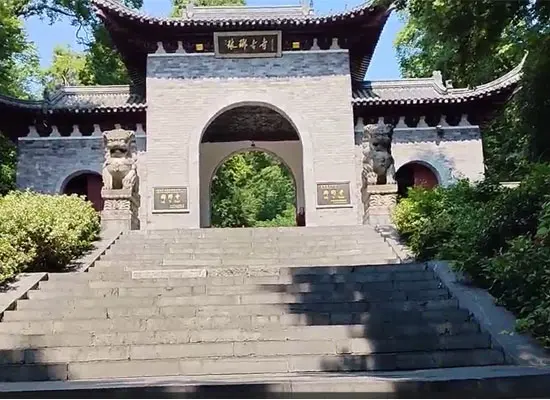
Back then, Chuzhou’s local official Li Youqing and monk Fanchen built the temple together. In the Tang Dynasty, Emperor Li Yu personally gave it the name “Baoying Temple”, and in the Song Dynasty it was renamed “Kaihua Zen Temple”. However, the people preferred to use the name of the mountain to call it, and over time, the name “Langya Temple” has been spread.

When you walk into Luangya Temple, the first thing you can see is a bell tower hung with red lanterns, called the Century Bell Tower. On the second floor of the bell tower hangs a huge copper bell. This bell is very heavy, 3 tons, 2.4 meters high and 1.6 meters wide. Every morning, the monks in the temple ring it to tell everyone that a new day has begun and so has the monks’ life.

Next to the bell tower are the steps leading to the Hall of Heavenly Kings. This is a very special section of steps, with a total of 108 steps. When you get about halfway up the steps, remember to look to your left. There stands a jade-carved Guanyin statue. Look closely and you will see that this statue is male-like. According to the ancient Buddhist scripture, the Lanyan Sutra, Guanyin is so compassionate that he can change into 32 different forms to teach people in order to help all kinds of people, and one of them is a male figure.
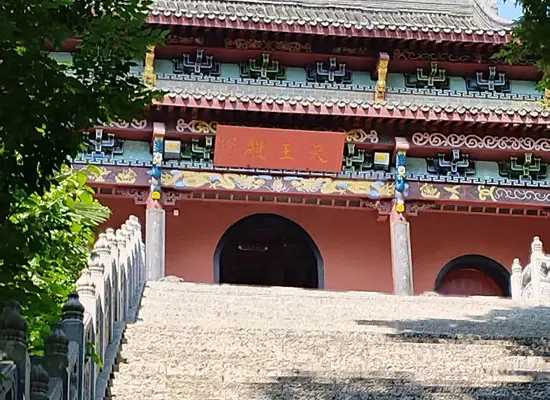
The Hall of Heavenly Kings is one of the important buildings of Luangya Temple, which was built in the Ming Dynasty. Inside the hall is enshrined the smiling Maitreya Buddha. To his left and right stand four mighty idols of the Heavenly Kings. The carvings in the hall are particularly exquisite, showing that the ancient craftsmen were very skillful.

Walking through the Hall of the Heavenly Kings, in front of us is a pool, called the “life release pool”, some people also call it “Mingyue pool”. The water in the pool will not dry all year round. Look at the bottom of the pool, the sunshine coins in the glittering. Often tourists throw coins into the pool to pray for blessings. On the left side of the pool, there is a stone turtle carrying a big treasure, symbolizing wealth and longevity; on the right side, there is a stone carp, which means good luck and success. Above the pool there is a stone bridge with three holes, because it was built over the Mingyue Pond, so it is called the Mingyue Bridge.
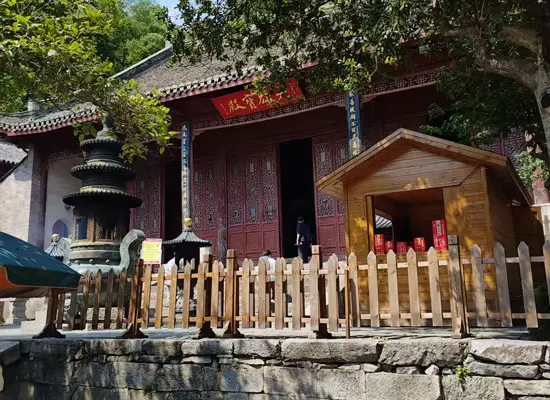
The most important hall of Luangya Temple is the Mahavira Hall. It is very high, 12 meters, very deep, 15.3 meters, was built in 1916. The Buddha statues in the former hall were later destroyed. By 1981, people reshaped the Buddha statues inside.
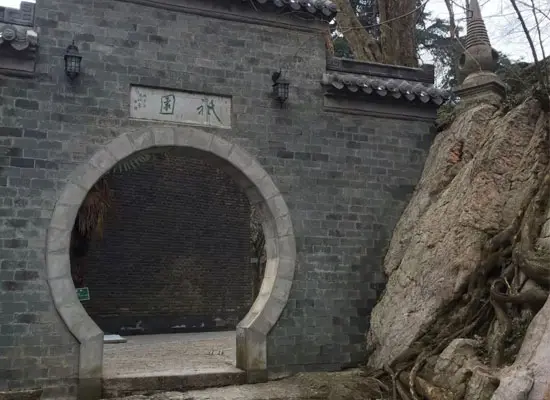
From the right side of the Mahamudra or the back path, you can reach a place called QIyuan Garden. This garden contains a number of monuments, such as ancient writings carved into the rocks of the mountain (cliff stone carvings), a cedar tree gifted by Ms. Soong Ching Ling, and a statue of the Goddess of Mercy that is said to have been painted by the great ancient artist Wu Daozi.

Behind the Da Xiong Bao Dian is the Tibetan scripture building. It encloses a small courtyard by itself. There is a round doorway in the center of the courtyard. Above the doorway, there are four big characters “Sanzang Xuanshu”, written in the old scribal script.

After looking at the small courtyard of the scripture building, you will see a stone carving with the word “Enlightenment” engraved on it. If you walk to the left, you will find Suehong Cave.

On the north side of Mingyue Bridge, there is a row of old cottages with a corridor and small tiles on the roof. This is called Mingyueguan.

In the small courtyard to the north of Mingyueguan, there is a pavilion and a spring. The pavilion is called “Three Friends Pavilion”. Why is it called that? Because next to the pavilion grew pine trees, bamboo and plum blossoms, which stayed together all year round. In the yard, there is a spring named “Maundy Spring” under the cliff.
Further on from the Three Friends Pavilion is the Jixinzhai. This is actually a vegetarian restaurant. You can order a vegetarian meal for 20 RMB. It’s interesting that they can use all-vegetarian ingredients to make something that tastes like a meat dish.

From the Three Friends Pavilion, walk south for about fifty meters. You will see a flight of steps going west. Walk up the steps and before you is the Beamless Hall. This building is very special, the whole house does not use a single wooden beam, it is completely built up with bricks and stones. It is a place dedicated to the Jade Emperor and belongs to the Taoist architecture. This hall is very old, it was built more than a thousand years ago (in the period of the Later Zhou Dynasty) and has been repaired many times since then. The Beamless Hall we see now was rebuilt in the early Ming Dynasty.
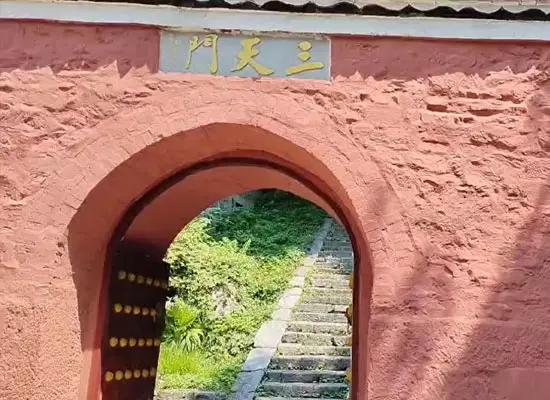
There is also a “Three Heavenly Gates” on the hill to the south of the Wuliang Hall. It was built more than four hundred years ago (in 1599, the 27th year of the Wanli reign of the Ming Dynasty).
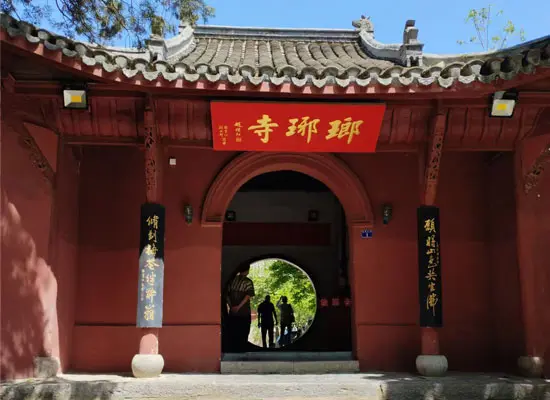
Walking back from the Wuliang Hall, you can go back to the back door of Luangya Temple. Going out of the back door, you will see the place called “Luangya Shengjing” in front of you. From here, you can go directly to the South Heavenly Gate and Langya Pavilion.

